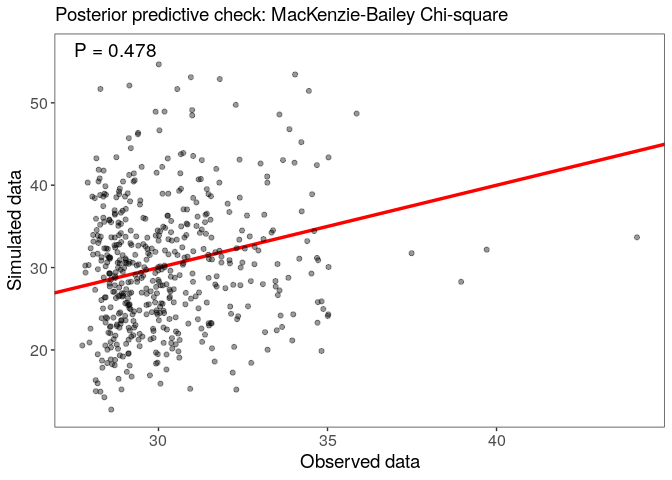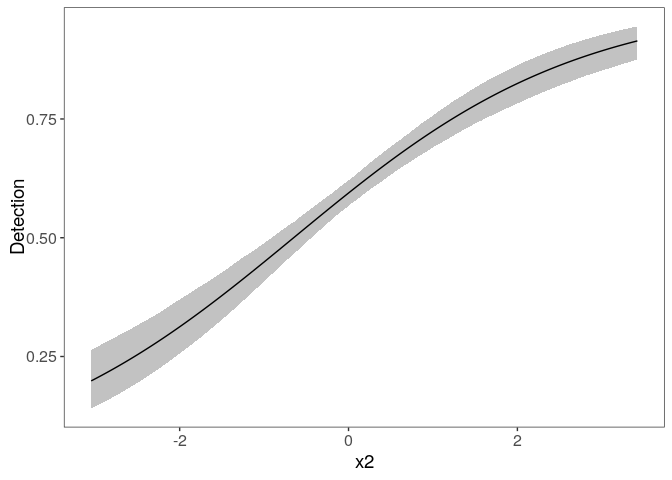ubms is an R package for fitting Bayesian hierarchical models of
animal occurrence and abundance. The package has a formula-based
interface compatible with
unmarked,
but the model is fit using MCMC with Stan
instead of using maximum likelihood. Currently there are Stan versions
of unmarked functions occu, occuRN, colext, occuTTD, pcount,
distsamp, and multinomPois. These functions follow the stan_
prefix naming format established by
rstanarm.
For example, the Stan version of the unmarked function occu is
stan_occu.
Advantages compared to unmarked:
- Obtain posterior distributions of parameters and derived parameters
- Include random effects in parameter formulas (same syntax as
lme4) - Assess model fit using WAIC and LOO via the loo package
Disadvantages compared to unmarked:
- MCMC is slower than maximum likelihood
- Not all model types are supported
- Potential for convergence issues
ubms is on
CRAN:
install.packages("ubms")Alternatively, the latest development version can be installed from Github:
# install.packages("devtools")
devtools::install_github("kenkellner/ubms")Simulate occupancy data including a random effect on occupancy:
library(ubms)
set.seed(123)
dat_occ <- data.frame(x1=rnorm(500))
dat_p <- data.frame(x2=rnorm(500*5))
y <- matrix(NA, 500, 5)
z <- rep(NA, 500)
b <- c(0.4, -0.5, 0.3, 0.5)
re_fac <- factor(sample(letters[1:26], 500, replace=T))
dat_occ$group <- re_fac
re <- rnorm(26, 0, 1.2)
re_idx <- as.numeric(re_fac)
idx <- 1
for (i in 1:500){
z[i] <- rbinom(1,1, plogis(b[1] + b[2]*dat_occ$x1[i] + re[re_idx[i]]))
for (j in 1:5){
y[i,j] <- z[i]*rbinom(1,1,
plogis(b[3] + b[4]*dat_p$x2[idx]))
idx <- idx + 1
}
}Create unmarked frame:
umf <- unmarkedFrameOccu(y=y, siteCovs=dat_occ, obsCovs=dat_p)Fit a model with a random intercept, using 3 parallel cores:
(fm <- stan_occu(~x2 ~x1 + (1|group), umf, chains=3, cores=3, seed=123))##
## Call:
## stan_occu(formula = ~x2 ~ x1 + (1 | group), data = umf, chains = 3,
## cores = 3, refresh = 0, seed = 123)
##
## Occupancy (logit-scale):
## Estimate SD 2.5% 97.5% n_eff Rhat
## (Intercept) 0.318 0.290 -0.254 0.887 926 1.001
## x1 -0.461 0.114 -0.683 -0.237 4428 0.999
## sigma [1|group] 1.337 0.261 0.911 1.924 2112 1.002
##
## Detection (logit-scale):
## Estimate SD 2.5% 97.5% n_eff Rhat
## (Intercept) 0.383 0.0607 0.265 0.503 4539 1
## x2 0.586 0.0591 0.470 0.704 4963 1
##
## LOOIC: 2267.291
## Runtime: 27.948 sec
Examine residuals for occupancy and detection submodels (following Wright et al. 2019). Each panel represents a draw from the posterior distribution.
plot(fm)Assess model goodness-of-fit with a posterior predictive check, using the MacKenzie-Bailey chi-square test:
fm_fit <- gof(fm, draws=500)
plot(fm_fit)Look at the marginal effect of x2 on detection:
plot_effects(fm, "det")A more detailed vignette for the package is available here.


